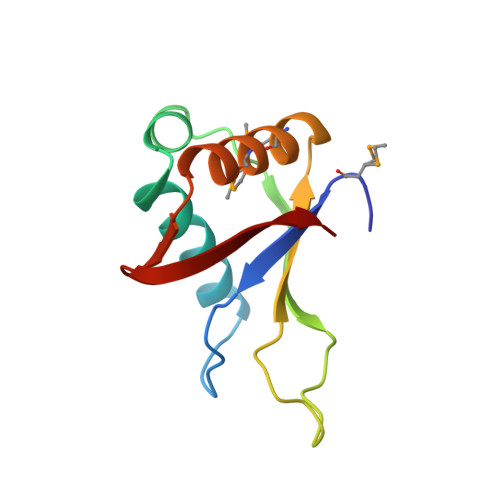Non-Ltr Retrotransposons Encode Noncanonical Rrm Domains in Their First Open Reading Frame.
Khazina, E., Weichenrieder, O.(2009) Proc Natl Acad Sci U S A 106: 731
- PubMed: 19139409
- DOI: https://doi.org/10.1073/pnas.0809964106
- Primary Citation of Related Structures:
2W7A - PubMed Abstract:
Non-LTR retrotransposons (NLRs) are a unique class of mobile genetic elements that have significant impact on the evolution of eukaryotic genomes. However, the molecular details and functions of their encoded proteins, in particular of the accessory ORF1p proteins, are poorly understood. Here, we identify noncanonical RNA-recognition-motifs (RRMs) in several phylogenetically unrelated NLR ORF1p proteins. This provides an explanation for their RNA-binding properties and clearly shows that they are not related to the retroviral nucleocapsid protein Gag, despite the frequent presence of CCHC zinc knuckles. In particular, we characterize the ORF1p protein of the human long interspersed nuclear element 1 (LINE-1 or L1). We show that L1ORF1p is a multidomain protein, consisting of a coiled coil (cc), RRM, and C-terminal domain (CTD). Most importantly, we solved the crystal structure of the RRM domain, which is characterized by extended loops stabilized by unique salt bridges. Furthermore, we demonstrate that L1ORF1p trimerizes via its N-terminal cc domain, and we suggest that this property is functionally important for all homologues. The formation of distinct complexes with single-stranded nucleic acids requires the presence of the RRM and CTD domains on the same polypeptide chain as well as their close cooperation. Finally, the phylogenetic analysis of mammalian L1ORF1p shows an ancient origin of the RRM domain and supports a modular evolution of NLRs.
- Department of Biochemistry, Max Planck Institute for Developmental Biology, Spemannstrasse 35, 72076 Tübingen, Germany.
Organizational Affiliation:


















